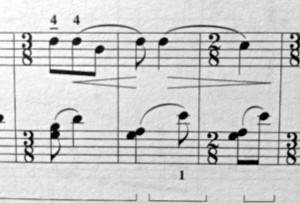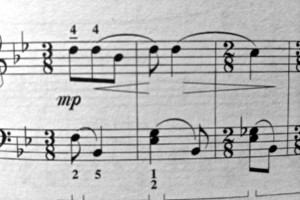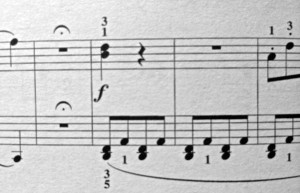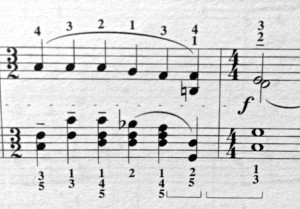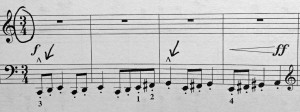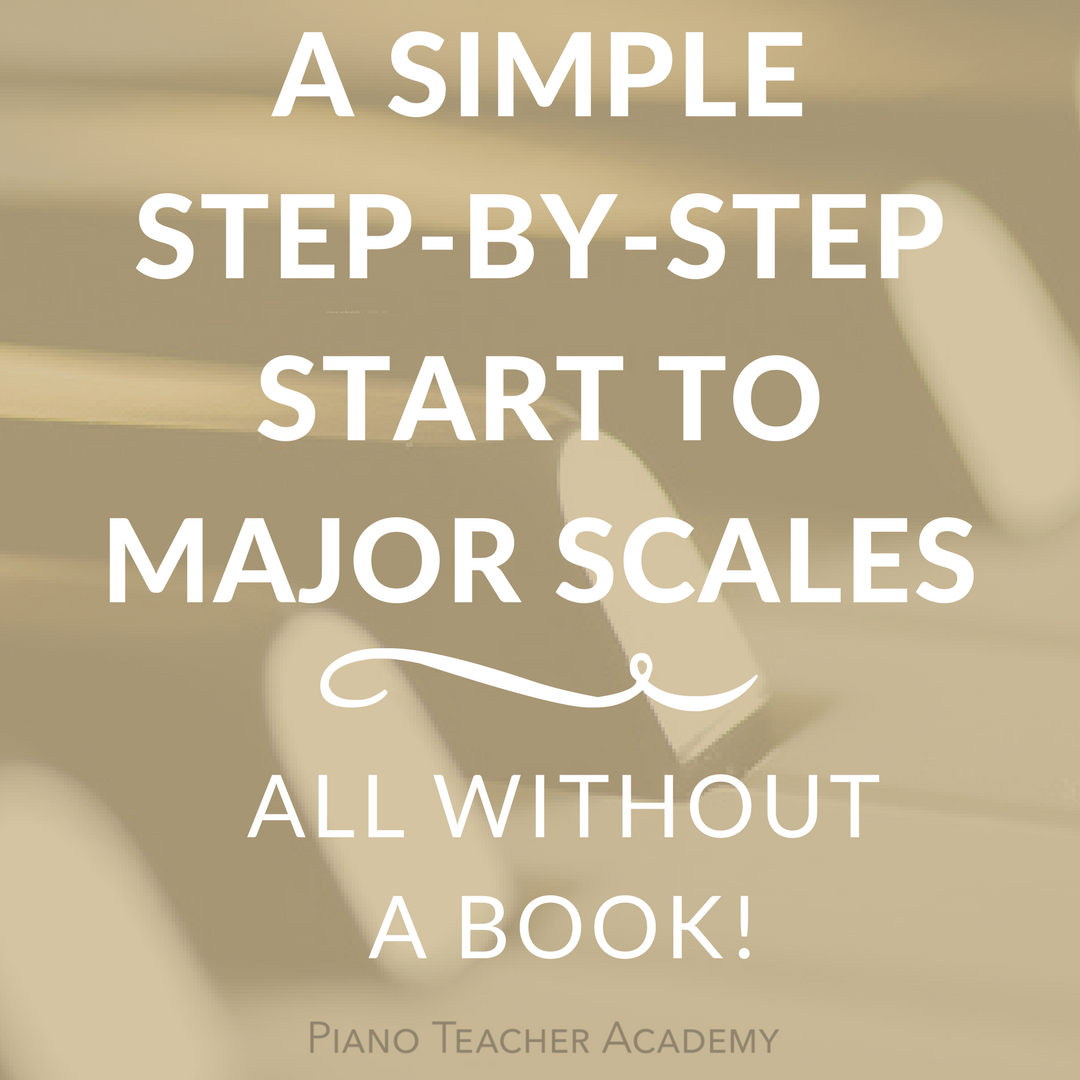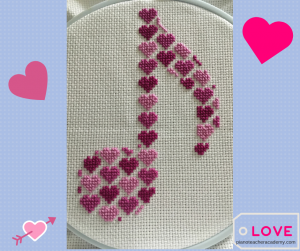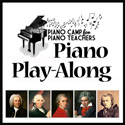Bartok, For Children Vol. I, Play-Along: Post Five (Nos. 26 – 30 Reaction)
I’ve decided to have all the pre-college students in my studio (15 of them) work on Bartok pieces this spring. We always have a theme for our May recital and since we’ve never had a composer for a theme, why not try Bartok? I’d like to see how my students react to his writing. So far, so good. I played some examples from For Children, Book I for a couple of intermediate to late-intermediate students the other day and they had no problem selecting one that really appealed to each of them. I’ll list all the pieces the students choose as their recital pieces in a later post.
Quick-scan observations about Nos. 26-30 :
- All pieces are EI to I (Early Intermediate to Intermediate) in level.
- Continued use of simple keysignatures, major and minor modes.
- Bartok introduces more than one meter in a single piece (multi-meter) and uses it in 3 of the pieces.
- Chorale style is introduced.
Impressions While Playing: Another one of Bartok’s contemplative pieces. A rather tender, sweet piece, yet mournful at the same time. The minor chords in the harmony seem to promote that feeling.Besides all the modulations from major to minor, you can’t help but notice the mixed meter from the start — 3 + 3 + 2 phrasing. There’s only a few places where Bartok extends the 3-measure phrases into 5-measure phrases (EX: mm. 13-17. )As I played I really enjoyed the modulations. Here’s a little flow chart of how the key areas progressed:
M. 1 G minor — M. 9 B-flat Major — M. 15 D minor— M.18 B-flat Major— M. 24 E-flat Major— M.29 B-flat Major— M. 32 G minor
The harmonies and rhythm are what appealed to me most in this piece. Lots of color and lilt.
Teaching Value: This would be a great rhythmic study for an early intermediate student who hasn’t had much exposure to multi-meter. After counting the recurring 3-measure phrase several times like this 1-2-3-1-2-3-1-2, you start to get the feel for the flow of the phrase. I would also have a student label the harmonic shifts directly in the score (as seen above in the chart) and ask them to notice how each harmony is related to the Key of G minor.
Take Note: Did you notice that this piece consists only of a single melodic theme which is repeated with a different harmonization the second time? But…..did you also notice that the LH broken-chord accompaniment moves upward at the beginning and then moves downward later when the theme returns. See below.
Note how often the RH and LH release their slurs at different times. Quite tricky, but it can be worked out slowly at first. Despite all the pedal indications, it’s important to execute all of the short slurs. You can really hear slur releases even while the pedal is holding.
Recommended For: Students who might need a rhythm, slur, and pedaling challenge all at the same time. A student should already be proficient in slurred articulation and should have a strong awareness of a steady pulse. Pedal should be added at the latest stage.
Correlates To: Faber mid-Level 3B or higher (EI)
No. 27 – Jest
Impressions While Playing: This sprightly piece is Bartok’s typical bouncy style we’ve noticed so far with a playful melody and rhythmic accompaniment. Again, he repeats the melody twice here, but with each repeat he varies the accompaniment and/or the harmonies. I especially like how Bartok interrupts the “jesting” with rallentando moments (EX: mm. 12-13). Perhaps the “jester” is apologizing for what he/she said? But only to continue the jest immediately after (mm.14-16).Teaching Value: It’s important for younger students to know what a “jest” really is. That’s not a typical word used often in today’s vernacular ( a “joking remark” or “good-natured teasing”). With the meaning in hand, a student can then begin to characterize each repeat of the melodic theme in a different way, and also describe through tone what might be happening at the rallentando areas. And perhaps the “jest” becomes intensified at m.33? See below.
Take Note: MM. 39 – 45 —- notice how the “jesting” just seems to melt away here. I would spend a good deal of time here helping a student with this melt-down (slowing down and getting quieter) and the don’t forget the fermata! Waiting highlights all the suspense of what might come next. Notice how the previous fermata in m. 32 appeared before the theme and the this one appears before the final cadence. Quite a different effect!
Recommended For: Students who love capricious pieces and are interested a characterizing an idea. The student should be proficient in LH alberti bass execution and familiar with D Major.
Correlates To: Faber 3B or higher (EI-I)
No. 28 – Choral
Impressions While Playing: This is the first true chorale seen in this set so far, set in a D Dorian/minor mode. He throws in a few accidentals to shift the harmonies in different directions making it very colorful and interesting. Once again Bartok has re-harmonized a single melodic theme, twice this time, and with each repeat the melody sounds quite different.
Teaching Value: At first glance this piece may seem straightforward, but in true Bartok style, he has incorporated many fine details in meter (multi-meter), articulation, dynamic, voicing (imitation occurs), and especially fingering. Take a glance here at his specifics given for executing a truly legato LH passage, fingering and pedal:
Take Note: Despite all the 4-part harmonies (polyphony) Bartok uses throughout the piece, notice how he chose a strong monophonic ending to the piece (single melody duplicated in both hands). Such a bold close to a chorale.
It took me several playings to soak in all the different harmonizations Bartok created for the repeated melodic theme (mm. 1 through 13 comprises the overall theme). Try a little experiment as I did. Play a portion of the theme, for example, mm. 7 -10, and then play the later repeats of this melody. It’s really fascinating how the mood changes with each new harmonization that Bartok provided for this phrase.
Recommended For: A more mature student who is proficient with expressive details of phrasing, voicing, and articulation, one who is good listener and observer, and one who is interested in experimenting with tonal color. Previous experience in chorale-style writing would be helpful.
Correlates To: Faber 4 or higher (I)
No. 29 – Pentatonic Tune
Impressions While Playing: This is a clever juxtaposition of 2 perky themes using the pentatonic scale of : G – A – B – D – E
The first theme (m.1) and second theme (m. 9) alternate and are variated until measure no. 41 when Bartok combines the two together in a type of call-and-response. Quite clever and fun to play once you get the hang of it, but a little more deceptive than it looks!
Teaching Value: This piece offers the student two distinctly different themes to play — a monophonic one and a homophonic. In the latter, the LH always takes the melody.
The fast grace notes could be quite tricky. Students often struggle with them, so try this solution — Play both notes at the same time (the grace note and the main note) and you’ll get the same “grace note” effect, but it will be much, much easier to execute!
VIDEO DEMO of grace note execution
Take Note: Did you notice how quiet most of the piece should be played? And did you feel the difference between page 1 and page 2? The hands are much closer together on page 1 and far apart on page 2.
Recommended For: A student who loves gymnastics, but one who can already play, or would like to learn, quick short staccatos at a P level. Once the student masters the basic execution of the themes and understands the octave shifts, it would all come together rather quickly. A moderate tempo should be accomplished first before rising to “scherzando.”
Correlates To: Faber 4 or higher (I)
No. 30 – Jeering Song
Impressions While Playing: Can you hear the “jeering?” There are many “jabbing” phrases. The switch from 3/4 to 2/4 promotes this effect. There’s quite a bit of energy and variety here despite the brevity of this piece (36 seconds). I think intermediate students would be attracted to it for both reasons, which is why this piece is already a Bartok favorite. I certainly enjoyed playing it again and again.
Teaching Value: A fantastic exercise in rhythm! Notice in mm. 9 – 12 how Bartok has included rooftop accents to emphasize 2-measure phrases. I know that most students would have the inclination to throw an accent on the lower notes and not play this passage in true 3/4 time.
I like how the piece offers both RH and LH a chance to play the melody, with one hand in C Major and the other in A Major. Nice color change! And who can get bored from moving around the piano?
Take Note: Did you notice how almost all of the piece is played staccato, except for where Bartok has indicated marcato or has written long tones? And did you hear the interesting modulation from A Major to C major in mm. 21-25? The dynamic shift here really brings it to life.
Try the Ossia RH figures in mm. 13-21. It requires a larger hand, but the resulting sounds are quite colorful.
Recommended For: A student with previous experience in playing quick, staccato pieces with repeated notes and/or repeated chords in clean, detached style. This piece requires quick “impulse” playing (playing a rhythmic idea all from one gesture)
Correlates To: Faber 4 or higher (I) — moves about quite a bit, and at a good clip.
I can see my students gravitating towards the energetic pieces in this set. What about you? If you don’t teach or teach at this level, which of these 5 captured your attention?
